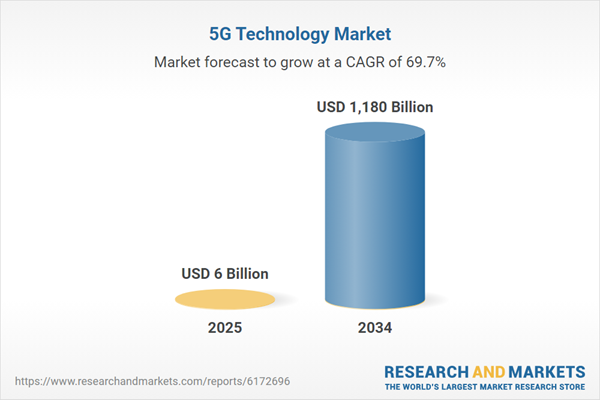Fast Network and Digitisation of End Use Industries are Aiding the Market Growth
The market for 5G technology is expanding rapidly due to the rising demand for fast wireless internet. The growing demand for video conferencing, distant learning, and multiple user gaming also aid the market growth. 5G technology also increases the speed and quality of various functions, such as ultra-HD video streaming, and the control of robots and drones. Emerging technologies such as virtual reality (VR), and augmented reality (AR), among others, demand fast and efficient network and accelerates the market growth. The market is also fueled by various government initiatives including investments in technology developments. For example, the Indian government approved Rs. 12,195 crores for telecom gear manufacturing in India; initiatives such as this boost the industry. 5G relies on multiple spectrum bands-low band, mid band, and high band. This enables ultra-fast services for Internet of things (IoT), industries, as well as mobile devices and hence promotes compatibility across systems.Moreover, digitisation of manufacturing and other production processes can automatically generate, transmit and process data without human intervention, consequently lubricating the market growth. The development of smart cities and smart energy also aids in market growth. Advancement such as Internet of things (IoT) is expected to be a major driver for the industry, especially due to ultra-reliable low latency communications and massive machine-type communication provided by the 5G technology.
5G Technology: Market Segmentation
5G is fifth-generation mobile network which enables a new kind of network that is designed to connect virtually everything, including machines, objects, and devices. The wireless technology is meant to deliver multi GBps peak data speed, ultra-low latency, reliability, massive networks capacity, and improved efficiency.The major offerings of 5G technology are:
- Hardware
- Software
- Services
The market can be broadly categorised on the basis of its connectivity into:
- Enhanced Mobile Broadband (EMBB)
- Ultra-reliable Low Latency Communication (URLLC)
- Massive Machine Type Communication (MMTC)
Based on its applications, the market is segmented into:
- Connected Vehicles
- Monitoring and Tracking
- Automation
- Smart Surveillance
- VR and AR
- Enhanced Video Services
- Others
The major end uses of 5G technology are:
- Manufacturing
- Automotive
- Energy and Utilities
- Transportation and Logistics
- Healthcare
- Government
- Media and Entertainment
- Others
The report looks into the regional markets of 5G technology like:
- North America
- Europe
- Asia-Pacific
- Latin America
- Middle East and Africa
Advancing Technology to Bolster the Market Growth of 5G Technology
Surging demand for wireless broadband and faster internet are some of the major drivers for the market growth of 5G technology. This is attributed to the rising data demand caused by the increase in video consumption in recent years. Further, the increasing demand from autonomous vehicles is also boosting the growth of the industry. The extreme use of smartphones has also increased the need for faster internet. As the 5G technology enables the interconnectivity between numerous devices, as in smart homes and medical devices, it is increasingly used for both business and personal purposes, which further lubricates the market.High reliability and low latency are some of the key network characteristics for industries which are expected to boost the market growth. The efficient and faster transfer of data also provides aid. The growth of edge computing, which provides execution resources for applications with networking close to the end user, goes hand in hand with the growth of 5G technology. It also facilitates technological advancements such as network slicing, which can be dedicated to different purposes and hence are more user friendly. Additionally, it can also control the machinery of industrial plants, logistics, and automated transportation. It can also improve the quality of life of the city by placing various sensors in different parts and objects; it could be monitored, and the shared information would facilitate the navigation of autonomous cars and choose better routes and reduce the number of accidents. Therefore, 5G technology is expected to witness heightened demand over the forecast period, consequently boosting the market growth.
Key Industry Players in the Global 5G Technology Market
The report presents a detailed analysis of the following key players in the global 5G technology market, looking into their capacity, market shares, and latest developments like capacity expansions, plant turnarounds, and mergers and acquisitions:- Samsung Electronics Co Ltd
- Nokia Corporation
- Huawei Technologies Co., Ltd.
- Qualcomm Technologies, Inc.
- Others
Table of Contents
Companies Mentioned
The key companies featured in this 5G Technology market report include:- Samsung Electronics Co Ltd
- Nokia Corporation
- Huawei Technologies Co., Ltd.
- Qualcomm Technologies, Inc.
Table Information
| Report Attribute | Details |
|---|---|
| No. of Pages | 170 |
| Published | August 2025 |
| Forecast Period | 2025 - 2034 |
| Estimated Market Value ( USD | $ 6 Billion |
| Forecasted Market Value ( USD | $ 1180 Billion |
| Compound Annual Growth Rate | 69.7% |
| Regions Covered | Global |
| No. of Companies Mentioned | 5 |









